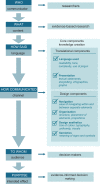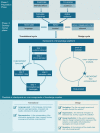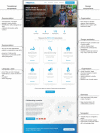From research to evidence-informed decision making: a systematic approach
- PMID: 29538728
- PMCID: PMC5896638
- DOI: 10.1093/pubmed/fdx153
From research to evidence-informed decision making: a systematic approach
Abstract
Background: Knowledge creation forms an integral part of the knowledge-to-action framework aimed at bridging the gap between research and evidence-informed decision making. Although principles of science communication, data visualisation and user-centred design largely impact the effectiveness of communication, their role in knowledge creation is still limited. Hence, this article aims to provide researchers a systematic approach on how knowledge creation can be put into practice.
Methods: A systematic two-phased approach towards knowledge creation was formulated and executed. First, during a preparation phase the purpose and audience of the knowledge were defined. Subsequently, a developmental phase facilitated how the content is 'said' (language) and communicated (channel). This developmental phase proceeded via two pathways: a translational cycle and design cycle, during which core translational and design components were incorporated. The entire approach was demonstrated by a case study.
Results: The case study demonstrated how the phases in this systematic approach can be operationalised. It furthermore illustrated how created knowledge can be delivered.
Conclusion: The proposed approach offers researchers a systematic, practical and easy-to-implement tool to facilitate effective knowledge creation towards decision-makers in healthcare. Through the integration of core components of knowledge creation evidence-informed decision making will ultimately be optimized.
Figures




References
-
- Bridging the ‘Know-Do’ Gap. Meeting on Knowledge Translation in Global Health. 10–12 October 2005, World Health Organization, Geneva, Switzerland; 2006.
-
- Graham I, Logan J, Harrison M et al. . Lost in knowledge translation: time for a map? J Contin Educ Health Prof 2006;26:13–24. - PubMed
-
- Brownson RC, Jones E. Bridging the gap: translating research into policy and practice. Prev Med 2009;49:313–5. - PubMed
-
- Landry R, Amara N, Lamari M. Utilization of social science research knowledge in Canada. Res Policy 2001;30:333–49.
Publication types
MeSH terms
Associated data
LinkOut - more resources
Full Text Sources
Other Literature Sources
Miscellaneous

